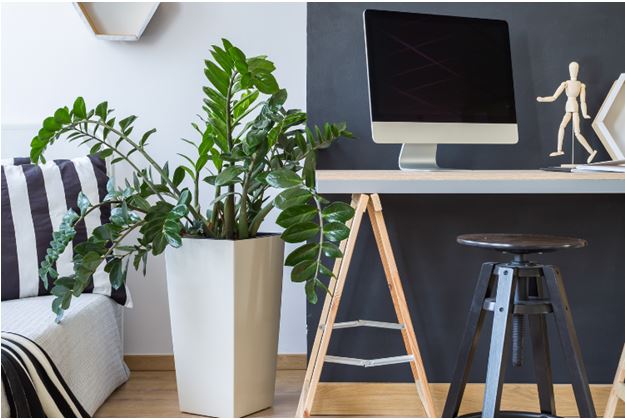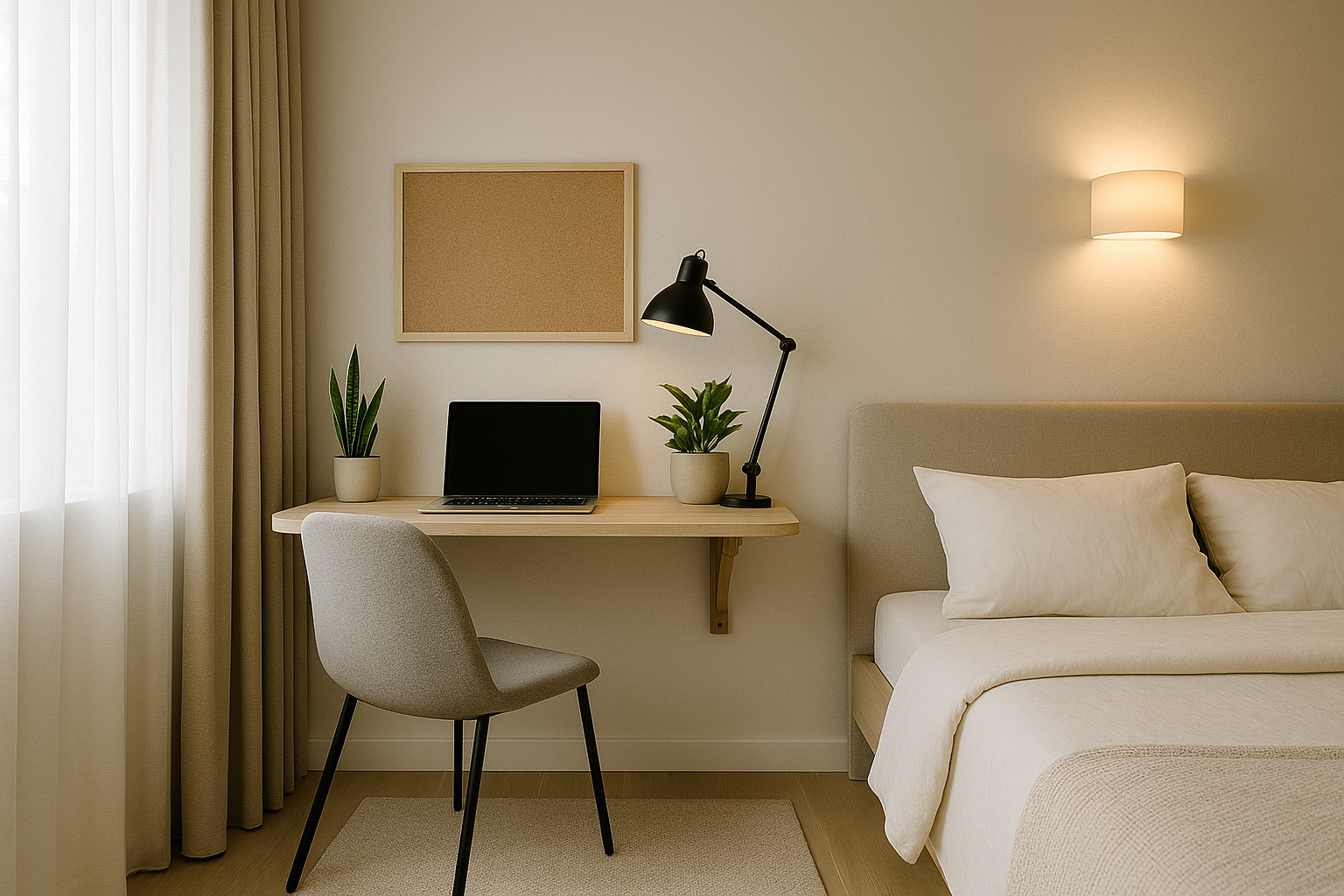Introduction
Creating a Productive Home Office in Your Bedroom is a design challenge that many remote workers face. The goal is simple. Protect the calm of your sleeping space while carving out a focused area for work that looks intentional and feels good to use.
If your bedroom is too small, there are innovative ways to find a larger room or apartment that suits your needs and routine. This guide shows you how to plan your layout, choose compact furniture, manage light and noise, and stay eco-friendly. You will also find practical advice for finding the right place to rent when it is time to upgrade.
Designing a Home Office in Your Bedroom
Your bedroom is a private retreat. When it must also host a workspace, balance is everything. Use the steps below to transform a corner into a clear and calm office that still feels like a bedroom at night.
Choose the best location.
Face the desk away from the bed when possible. It breaks the visual cue to lounge and helps your mind switch into work mode. In tiny rooms, create a visual partition so your bed is not in your line of sight while you work.
-
Renter-friendly separators include a slim bookcase, a folding screen, a ceiling-mounted curtain track, or a tall plant trio that softens the view.
-
Give the desk a “back” with a small rug and a task lamp. This anchors the zone without building walls.
Pick multifunctional furniture
Fewer pieces, better function. Look for items that have a minimal footprint.
-
Wall-mounted drop leaf desk that folds flat after hours
-
Narrow profile desk that doubles as a vanity with a drawer insert
-
Lift top storage bed or under-bed bins for paper, gear, and cables
-
A stackable stool or a compact ergonomic chair that tucks under the desk
Invite natural light
Daylight supports alertness and a stable mood. Place the work surface near a window whenever possible, and control glare with sheer curtains. Add layered light for cloudy days.
-
One bright task lamp at the desk
-
One warm ambient lamp on a dresser or nightstand
-
An optional clip light for video calls that stores in a drawer
Keep the workspace organized.
Clutter drains focus. Give every small item a home and keep cables off the floor.
-
Cable sleeve or adhesive clips along the underside of the desk
-
Drawer inserts for pens, chargers, and hard drives
-
Vertical file rack for the few papers you still need
-
A scan habit that moves paper to cloud storage each Friday
Use Online Platforms to Find the Right Room
If you’re looking for a more flexible living arrangement or a space with a shared home office, consider using platforms like spareroom.com to find the perfect room for rent. These platforms enable you to filter for specific needs, such as space for a home office, access to public transportation, and eco-friendly living options. You can search based on what’s important to you, ensuring you find your perfect match.
Decorate with purpose
Personal touches make the corner feel like yours. Choose a limited palette so the office blends with the room. Plants improve air quality and reduce stress levels, signaling that the work zone has begun.
-
Low care options include pothos, snake plant, and ZZ plant
-
Use one art ledge for swap-friendly prints that fit your palette
-
A cork or fabric pinboard keeps ideas visible without visual noise
Prioritize comfort and ergonomics.
Comfort protects your energy across long sessions. Invest in a chair with height adjustment, lumbar support, and a breathable back for much better comfort. Keep your elbows at right angles, your eyes level with the top third of your screen, and your feet flat on the floor or on a small footrest. If space is tight, try a sit-stand converter that folds away.
Manage noise and privacy.
Soft surfaces absorb sound. A rug, lined curtains, and a fabric headboard all help. If you share a home, consider adding white noise from a small fan or using a noise-canceling app during calls. For doorless rooms, a curtain on a ceiling track provides a quick and easy privacy solution that renters can remove later.
Keep it eco-friendly
Choose LED bulbs, a smart plug that automatically turns off the desk setup at the end of the day, and a laptop stand made from certified wood or recycled aluminum. Go digital to reduce printing, and donate the gear you replace.
Sample mini layouts that work
The window ledge office
A narrow desk sits under the window with a sheer panel to soften glare. A shallow rolling cart parks beside the desk for supplies. At night, the cart slides into the closet.
The alcove pocket office
A drop leaf desk mounts in a niche with a wall lamp above. A fabric curtain closes across the niche at bedtime, so the room reads as a bedroom again.
The dresser desk combo
A 36-inch writing desk pairs with a wall mirror. By day, it serves as a workstation, and by evening, it becomes a vanity. Drawer dividers manage the switch.
A quick shopping checklist
-
Narrow desk or wall-mounted drop leaf
-
Compact ergonomic chair or stacking stool with cushion
-
Task lamp with adjustable arm and LED bulb
-
Cable sleeve, surge protector, and adhesive clips
-
Drawer inserts, vertical file, and one paper tray
-
Sheer curtain for glare control and a lined curtain for privacy
-
Rug that fits the desk footprint for zone definition
-
Small plant and low-profile art or pinboard
Finding the Perfect Room or Apartment to Rent
Sometimes the room you have cannot deliver the workspace you need. If you are considering a move, make a clear plan and search with filters that reflect your work life.
Use the right platforms.
Online tools allow you to filter for home office needs, quiet streets, and transit access. On roommate-friendly platforms such as SpareRoom, you can search by room size, window orientation, and furnished options that already include a desk. Save searches and set alerts to act quickly.
Consider location and lifestyle.
A great work-from-home spot sits near transit, parks for quick breaks, and basic amenities. If you visit your new home office location occasionally, check your route and timing to ensure you arrive on time. Listen for street noise at various times, and inquire about the building’s rules for quiet hours and guest policies.
Focus on space, light, and air.
Bring a tape measure. Confirm that your desk, chair, and a small storage unit will fit with sufficient room to move around. Look for windows that bring in morning or midday light. Test cross ventilation with two open windows, especially if you prefer natural air to constant cooling.
Ask about the details that matter.
-
Internet options and typical speeds
-
Outlet locations and breaker limits
-
Policy on wall-mounted shelves or a curtain track
-
Storage availability for printers or extra gear
-
Pet policy: if you live with an animal that joins your calls
Choose eco-friendly apartments.
Search for buildings with efficient windows, LED standard lighting, water-saving fixtures, and recycling or compost programs. If the building has green certifications or an energy score, add them to your comparison sheet. An efficient building protects your budget and the planet.
Frequently Asked Questions
How can I separate work and sleep zones in a single bedroom?
Create a visual boundary. A slim bookcase, a folding screen, or a curtain on a ceiling track builds a mental wall. Anchor the desk area with a small rug and a task lamp to create a defined zone.
Where should I place the desk for the best focus?
Place it near a window for natural daylight and position it away from the bed whenever possible. If the layout forces you to face the bed, use a screen or tall plants to block the view.
What is the smallest desk size that still works
A 30- to 36-inch-wide writing desk is suitable for a laptop, lamp, and notepad. Pair it with wall shelves to free up the surface.
How can I improve the lighting for video calls in a small room?
Use your window as a soft key light. Add a clip light or small ring light at eye level for cloudy days. Warm a back corner with a lamp to avoid a flat look.
What renter-friendly changes make the most significant impact
Sheer curtains for glare control, a rug for sound and zone definition, adhesive cable clips, and a wall-mounted pinboard using removable strips.
Are standing desks practical in a bedroom
Yes, if you pick a compact model or a sit-stand converter that folds. Keep a small anti-fatigue mat under the bed when not in use.
How do I hide cables and chargers?
Use clips and a sleeve to route cables under the desk. Use a surge protector with a short cord and one desktop grommet box for easy access.
Which plants work best in low-light bedrooms
Snake plants, pothos, and ZZ plants do well with low to medium light and need little watering. Place them behind the monitor to soften the tech view.
How can I maintain the room’s feel as a bedroom after hours?
Use a nightly shutdown ritual. Close the laptop, turn off the task lamp with a smart plug, fold the chair under the desk, and slide a curtain across the office corner.
What should I look for when renting a larger room for work?
Measure the clear wall space for a desk, confirm the availability of window light and ventilation, test internet speeds, and check the building’s quiet hours. Ask about outlets and whether wall fixtures are allowed.
Conclusion
How to Create a Productive Home Office in Your Bedroom is really about clarity. You need to create a small, chic area that allows you to focus, while keeping the rest of the room free for relaxation. Choose renter-friendly moves that can all be undone on moving day, if necessary. If your existing room cannot be extended further, go for a larger room or an apartment with ample light and a homey feel, according to your routine. When you plan ahead, you can enjoy a calm retreat at night and a confident workspace every morning.


